There has been round of blog posts in the wake of an interview I had at Jared Trueheart’s Legends of Men blog. That interview spurred a response by Jason Ray Carney who disputes that sword and sorcery is man’s fiction. Daniel Davis joined in at his Brain Leakage blog. Jason Ray responded to that. Go read these posts. Jason said that Jared, Daniel, and I were hysterical. You are not objective when you are the subject of comment. So I need others to look over the posts and comment if you find where any of us were “hysterical.”
Jason Ray Carney’s stance is that sword and sorcery is “gender neutral.”
Gender neutrality: Are we talking androgyny, hermaphrodites, eunuchs, or neuters?
Sword and sorcery got its start in Weird Tales magazine with a few stories in its competitors Strange Tales and Strange Stories. I have already written on female readers of Weird Tales push back against Robert E. Howard once the Conan series got rolling. E. Hoffmann Price wrote later in Amra that Conan saved Weird Tales more than once.
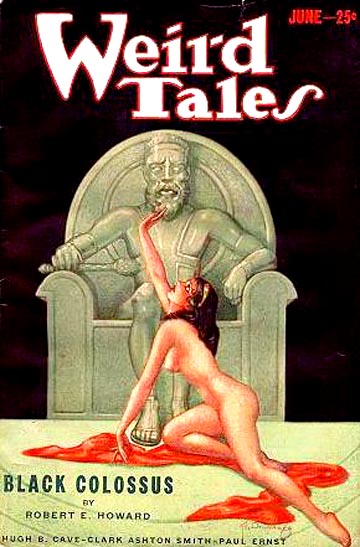
Farnsworth Wright knew his readers.
Let us look at some random issues of Weird Tales. September 1932– twelve stories and one poem. Two stories by women and one poem. October 1935– nine stories, three poems; one story by a woman. March 1938– 10 stories, two poems; one story by a woman. So, the average female percentage as writer is around 10%.
Now to the letters section, “The Eyrie,” to get an idea of female readership. August 1932– 12 letters, all from men. March 1934– 3 out of 19 letters by women. September 1938– 3 out of 23 letters by women. So, female readership of Weird Tales hovered somewhere around 12-15%. This is probably a higher percentage than the science fiction magazines of the period.
Weird Tales used Margaret Brundage as the almost exclusive cover artist from 1933-1936. Most of her paintings have nubile, beautiful young women in various stages of undress. Editor Farnsworth Wright was notoriously nervous about not alienating readers. He had no problem with art that would be considered offensive today. He must have had an idea of gender breakdown of readers.
The case of C. L. Moore is used as a battle cry as a True Cross for Amazon equality crusaders. I first read about Jirel and C. L. Moore from Avon’s Reader’s Guide to Fantasy in the early 80s. Ace Books did a mass market paperback collection in November 1982. I remember distinctly buying it along with two Fritz Leiber paperbacks in mid-May 1983. Back then, you could go to the local B. Dalton or Waldenbooks and get the paperback Conans, Elric, Fafhrd & the Gray Mouser, Kane, some Brak, David C. Smith, and even the Timescape Clark Ashton Smith. I tore into the first story in Jirel of Joiry, finding “Black God’s Kiss” on the slow side. “Black God’s Shadow” even slower and then just bogging down and scanning through the rest of the stories. This past winter, I reread the stories in detail and it was not a pleasant experience. Moore’s prose is painfully slow and overwritten. Her narrative also had a habit of turning into word salad at crucial scenes.
“Around the dark image a mist was swirling. It was tenuous and real by turns, but gradually she began to make out a ring of figures–girls’ figures, more unreal than a vision–dancing girls who circled the crouching statue with flying fee and tossing hair–girls who turned to Jirel her own face in in as many moods as there were girls. Jirel laughing, Jirel weeping, Jirel convulsed with fury, Jirel honey-sweet, Jirel convulsed with fury, a riot of flashing limbs, a chaos of tears and mirth and all humanity’s moods. The air danced with them in shimmering waves, so that the land was blurred behind them and the image seemed to shiver within itself.”
W.T.F?
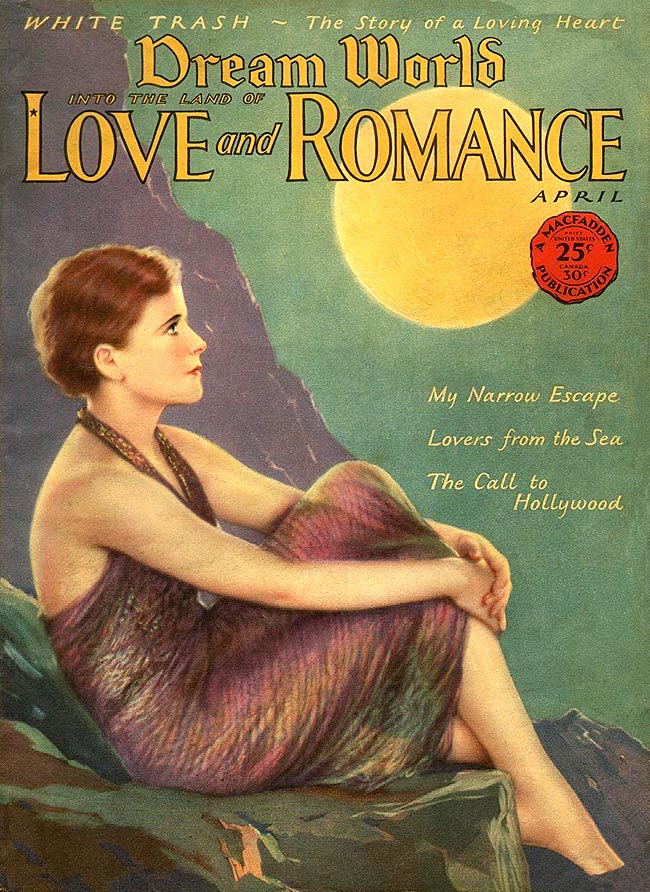 There is one scene at the beginning of “Jirel Meets Magic” where Jirel handles a sword. That is it. She deals with adversaries as a vehicle using supernatural third parties. When you look at the plots of the stories, “Black God’s Kiss” is a captivity/kidnapping narrative. It is The Sheik with hallucinogenic passages. “Black God’s Shadow” is the second half of a romance arc. As a friend of mine said, Jirel was treated rough by Guillaume and she liked it. “Jirel Meets Magic” is Alice in Wonderland. “The Dark Land” is another captivity story. “Hellsgarde” is a haunted house story. Moore did not seem comfortable writing scenes of physical combat as I could find only one brief scene of action but with no carnage depicted, just Jirel flailing around with her sword.
There is one scene at the beginning of “Jirel Meets Magic” where Jirel handles a sword. That is it. She deals with adversaries as a vehicle using supernatural third parties. When you look at the plots of the stories, “Black God’s Kiss” is a captivity/kidnapping narrative. It is The Sheik with hallucinogenic passages. “Black God’s Shadow” is the second half of a romance arc. As a friend of mine said, Jirel was treated rough by Guillaume and she liked it. “Jirel Meets Magic” is Alice in Wonderland. “The Dark Land” is another captivity story. “Hellsgarde” is a haunted house story. Moore did not seem comfortable writing scenes of physical combat as I could find only one brief scene of action but with no carnage depicted, just Jirel flailing around with her sword.
There have been three mass market and one trade paperback printings of the Jirel stories, each over a decade apart. That puts her a notch ahead of reprints of Norvell Page’s “Prester John” series. If Jirel is such an iconic series, why hasn’t the book been continuously in print? People like the idea of Jirel, people don’t like reading Jirel.
I was thinking of Moore’s influence through the Jirel series. The only thing that came to mind were two stories by Tanith Lee in the Amazons! Anthologies featuring “Jaisel” that read like homages to Moore. Moore’s writing itself just did not seem to have coat tails.
C. L. Moore’s writing style would change. Some stories reprinted in the collection Judgement Night are listed under Moore’s name instead of “Lawrence O’Donnell.” “Paradise Street,” “Heir Apparent,” and her novel Doomsday Morning are written in a stripped-down hard-boiled manner.
CL. Moore was a gracious and lovely lady from what anyone who met her has told me. One friend did tell that in the late 1970s at a science fiction convention, she laughed at the idea she was some sort of feminist icon.
If you add up the writers of sword and sorcery in the 1930s- Robert E. Howard, Clark Ashton Smith, H. Warner Munn, Nictzin Dyalhis, Clifford Ball, David H. Keller, Seabury Quinn, Henry Kuttner, Lloyd Arthur Eshbach, Fritz Leiber, Norvell Page, and C. L. Moore, you come up with a little under 10% female participation rate, a percentage that equals that of Weird Tales author breakdown and a little under the readership percentage.
There is a type of story found mainly in Planet Stories that is not technically sword and sorcery but has the attitude of it. Poul Anderson’s “Virgin of 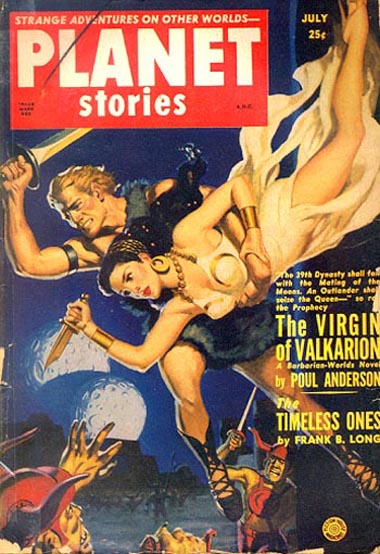 Valkarion” is Exhibit A. Leigh Brackett was a writer for Planet Stories in the 1940s with a few stories in the 1950s. Her writing style is a cross between Edgar Rice Burroughs and Dashiell Hammett. It is an interesting case of gender ventriloquism. Brackett wrote in a faux-masculine style most of the time. Every now and then the mask would slip as in “All the Colors of the Rainbow.” I can remember sending a Leigh Brackett book to a friend of mine. He returned it unimpressed. He pointed out a fight scene where Brackett had two guys rolling around in the dirt and the emphasis was on how they were getting their clothes dirty instead of physical damage. I can remember the first Brackett I ever read was “The Secret of Sinharat” and being disappointed at the rather tame ending. I was expecting Eric John Stark (aka N’Chaka) to pile up the bodies at the climax. The follow up “People of the Talisman” was more blood and thunder. That was the story that was rewritten by Brackett’s husband, Edmond Hamilton and expanded by 40%. I need to compare the texts someday.
Valkarion” is Exhibit A. Leigh Brackett was a writer for Planet Stories in the 1940s with a few stories in the 1950s. Her writing style is a cross between Edgar Rice Burroughs and Dashiell Hammett. It is an interesting case of gender ventriloquism. Brackett wrote in a faux-masculine style most of the time. Every now and then the mask would slip as in “All the Colors of the Rainbow.” I can remember sending a Leigh Brackett book to a friend of mine. He returned it unimpressed. He pointed out a fight scene where Brackett had two guys rolling around in the dirt and the emphasis was on how they were getting their clothes dirty instead of physical damage. I can remember the first Brackett I ever read was “The Secret of Sinharat” and being disappointed at the rather tame ending. I was expecting Eric John Stark (aka N’Chaka) to pile up the bodies at the climax. The follow up “People of the Talisman” was more blood and thunder. That was the story that was rewritten by Brackett’s husband, Edmond Hamilton and expanded by 40%. I need to compare the texts someday.
If we look at writers of sword and super-science for Planet Stories, the list includes: Gardner F. Fox, Bryce Walton, Emmett McDowell, Ross Rocklynne, Basil Wells, Erik Fennel, Alfred Coppel, Stanley Mullen, Poul Anderson, and Leigh Brackett. Again, the female participation rate is around 10%.
There were a few sword and sorcery stories that filtered out in the 1950s with E. E. “Doc” Smith, John Brunner, L. Sprague de Camp, and of course Jack Vance. The 1960s gave us Roger Zelazny, John Jakes, Michael Moorcock, Lin Carter, Gardner F. Fox, Ben Haas as “Richard Meade” and “Quinn Reade.” You did have Jane Gaskell’s “Atlan” books shoe horned into the genre. Those are Perils of Pauline type books featuring Cija. They are not very good but always seemed to have great covers whether by Frank Frazetta, Jeff Jones, Boris Vallejo, or James Gurney.
Leigh Brackett could have written a bona fide sword and sorcery story with an antediluvian setting and supernatural elements in the late 1960s once the sword and sorcery rebirth happened. Editors would have snapped up anything she wrote. She didn’t but she at least gave us the excellent Skaith trilogy which had its share of physical action.
Sword and sorcery spread out into popular culture starting around 1966 with the paperback books and the Warren magazines. It got to the point you could buy Frank Frazetta posters at a lot of record stores. Bands like Nazareth were using sword and sorcery imaging on their record album sleeves.
Ted White became editor of Fantastic Stories in 1969. The magazine was a grab-bag of different types of stories. Sword and sorcery did have an increasing presence. White tapped into all sorts of artist talent and you had very traditional sword and sorcery type covers by Jeff Jones, Esteban Maroto, Doug Beekman, and especially Steve Fabian who painted idealized female bodies. Ted White must have known who was buying the magazine.
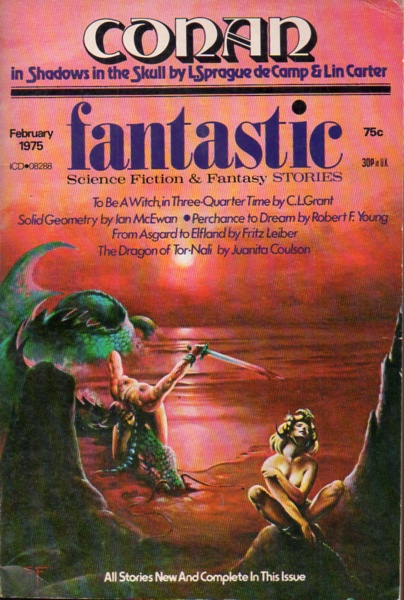
Ted White knew his readers.
In the middle 1970s, you had the next great female talent, Tanith Lee. I have written on her sword and sorcery when she died. She was unique. I prefer her stories to her novels, but her novels are preferable to most other fiction out there.
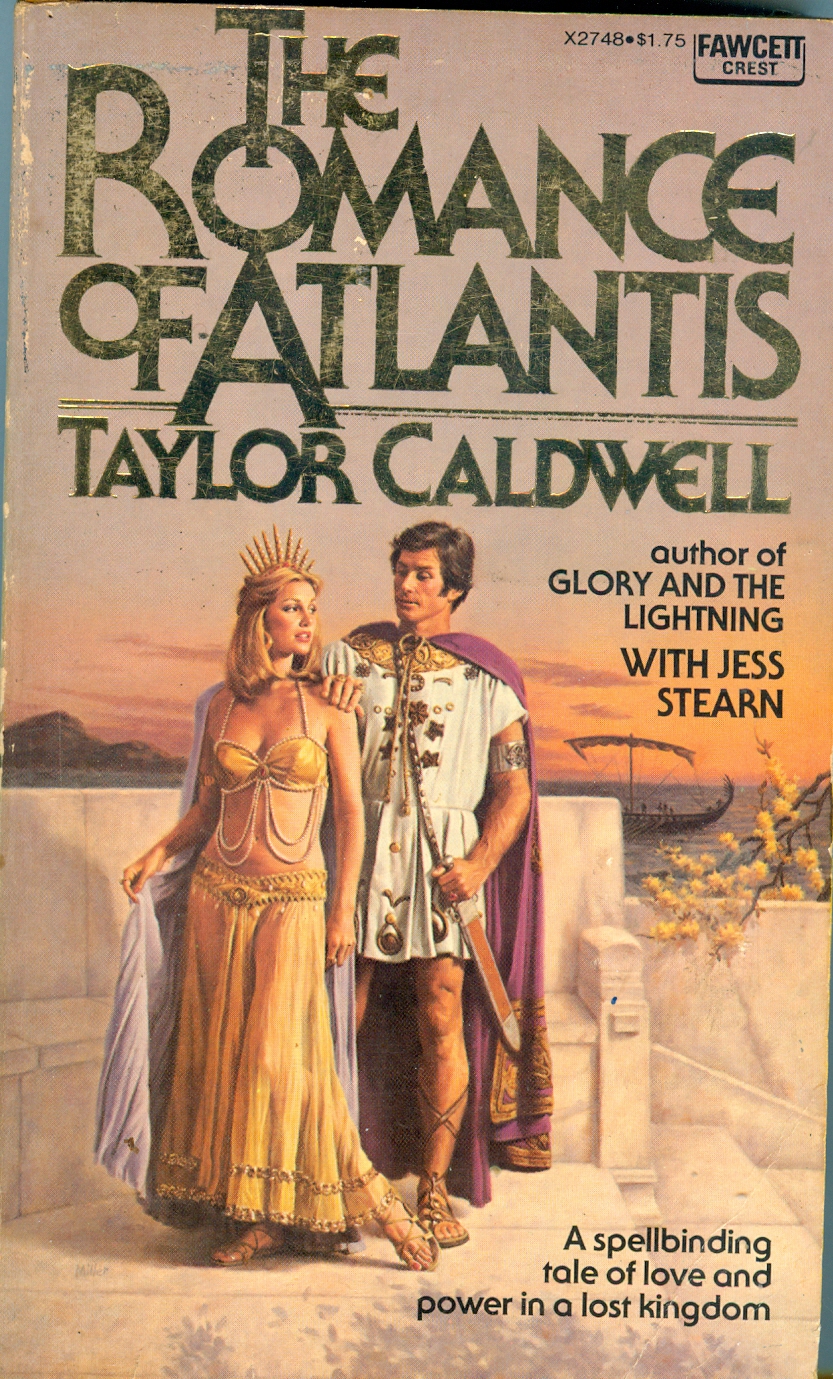
Not Sword and Sorcery
Lee showed up in the original sword and sorcery anthologies of the late 1970s. Swords Against Darkness ran for five volumes 1977-1979. It had a total of 57 stories. Seven stories and one poem were by females for a participation rate of 14%. Heroic Fantasy (D.A.W. Books, 1979) had 17 entries (including some non-fiction pieces), two were by female for a participation rate of 11.7%. Tanith Lee was present in five out of six of those anthologies.
Jessica Amanda Salmonson edited two Amazons! anthologies. Technically, they are not sword and sorcery but amazon anthologies. Amazons! (D.A.W. Books, 1979) was able to invert the gender ratio to 10% men, 90% women. Amazons II (D.A.W. Books, 1982) had 12 stories, three by men, so the male component rose to 25%. Salmonson probably took the series as far as she could though she edited two more general fantasy anthologies for Ace (Heroic Visions).
Marion Zimmer Bradley edited the Sword and Sorceress anthology for D.A.W. Books. It has all the appearance of continuing the idea of Salmonson’s Amazons! But with an in-house writer. The books were not so much sword and sorcery but fantasy of all sorts with a feminist orientation. The first volume had 15 stories, six by men for a 40% participation rate. That would shrink in subsequent volumes. It has a type of fiction that I call “femizon” which split off into its own genre the same way Glen Cook did with military fantasy around the same time.
One last example. My favorite sword and sorcery anthology of the past 10 years is Rogue Blades’ Entertainment’s Return of the Sword. The stories were by amateurs and small press people. It has heart and sincerity. 21 stories by 22 authors, three females for a 13.6% participation rate. Again, right in our consistent percentage.
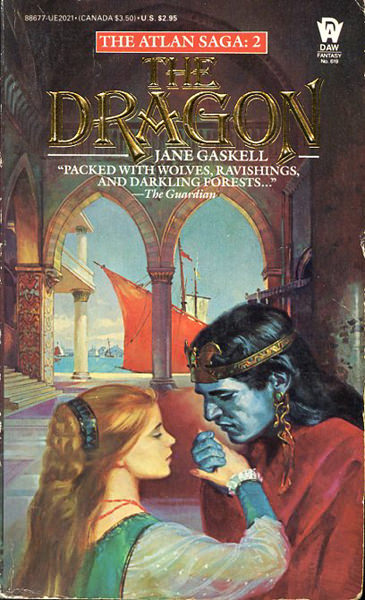
Not Sword and Sorcery
A personal observation: I have known two women personally that like reading Robert E. Howard’s Conan stories. One is mid-50s, the other around 60. One is a pharmacist, the other a nurse that runs a hospital operating room. So, just like the authors, the XX chromosome readers are on the rare side. I think most women are not particularly interested in reading fiction with lots of scenes of intense physical action.
I will give an anecdote that forms opinions. About 15-16 years ago, my office manager’s high school aged daughter read The Lord of the Rings. I thought I would build on that. I lent her one of L. Sprague de Camp’s sword and sorcery anthologies, either Sword & Sorcery or The Spell of Seven. Either of those books are excellent introductions to the genre. She did not like the book as she had problems with the vocabulary. She was constantly going to the dictionary to look up the meaning of words. If you want your kid to score high on the English portion of the S.A.T test, have them read sword and sorcery fiction. Then I lent her Poul Anderson’s The Broken Sword. She did not like that at all. It really upset her. Sword and sorcery is not going to pass through the feminine filter of a good portion of the fairer sex.
This came to me this week. A good portion of women like horror especially that more in the Gothic fiction end of the spectrum. Horror light if you will. There might have been an opportunity for a clever editor to sell sword and sorcery disguised as gothic romance to women readers. Phyllis Whitney did have a story in Weird Tales in the 1930s.
Here is a writing exercise of high school or college students. Have them start with a scene of traveler in the woods looking for shelter and finding a manor or castle. See how the story breaks down between the sexes.
So to wrap this up. My friend, the late Steve Tompkins used a phrase “the exception that proves the rule.” Crunching some numbers confirmed my suspicions. The history of sword and sorcery has had a few female outliers who wrote in the genre but the 10-12% rule appears consistent for decades.
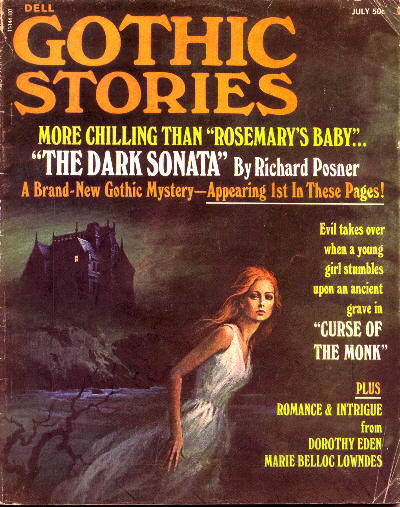
Where’s the Sword and Sorcery?
Sword and sorcery fiction may not be totally male, but it skews heavily in the XY chromosome end of the spectrum. Women were not excluded but participation has not been beyond minority entries. I think gender skewed, not gender neutral is a better way to describe the genre. Editors including Don Wollheim, Donald R. Benson at Pyramid, Larry Shaw at Lancer and then Dell, and Roy Torgeson at Zebra were quite happy to pick up a few female readers along the way, but they knew which side their bread was buttered on when publishing sword and sorcery. If the genre is gender neutral, why did the incoming female editors such as Betsy Wollheim at D.A.W. Books and Susan Allison at Ace Books pretty much kill off publishing sword and sorcery? Wouldn’t all the female readers keep it going? I was there, there was a K-T event in 1985. A few books that were already probably slated made it into the later 1980s, but the genre was decapitated. David Gemmell adapted by writing 300 page + novels with an ensemble cast and lots of domestic goings on but the efficient 60,000 word novel featuring one hero was gone.
This is an example our modern society’s obsession with equalitarianism. De-gendering the genre strikes me as post-modernism. It is also risible. A few weeks ago, an endocrinologist was telling me about hormone supplementation for trans-gendering. The men upon getting estrogen become emotional and weepy. The women getting testosterone develop a sense of humor and are generally less depressed.
I can sympathize with Jason Ray Carney. He teaches at a college. If he were outed that he is interested in what is perceived as masculine fiction, outside of a few sane colleges like Hillsdale or Grove City, he would be hauled up against a tribunal by the commissars for Wrong Think.
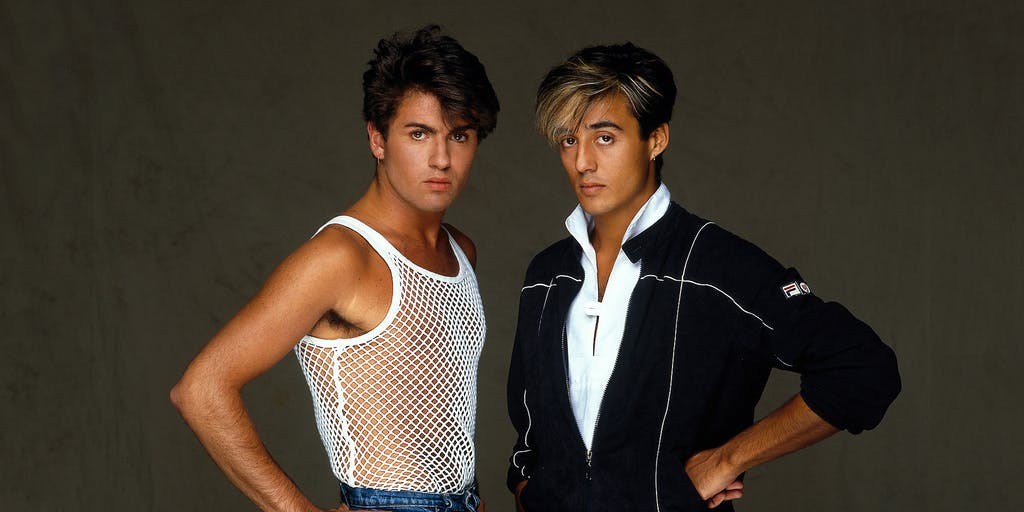
Gender Neutral
Interesting discussion.
I read through all of those posts and I didn’t see anything that looked hysterical.
I highly enjoyed Jessica Amanda Salmonson’s Tomoe Gozen trilogy, but was discombobulated to learn he/she is some sort of transsexual.
https://en.wikipedia.org/wiki/Jessica_Amanda_Salmonson
Ray Carney is a talented writer. His story in Cirsova 10is great S&S.
The article generally made sense to me, and was interesting and educational. However, your example of ‘word salad’ is clear enough to me on a slow skim.
I think Carney’s use of hysterical is comparable to over zealous. David Smith’s support of Carney’s literary critique of S&S is spot on. The argument against Smith’s response was hysterical and man-child in nature. Your take, and supporting evidence, is good and to the point but is not arguing on the same level of nuance as Carney. It’s as if he is saying water is the combination of two gases and you are saying water is wet. Both are correct but their frame of reference is different. I enjoyed the read. Looking forward to more.
-
No David Smith’s comments were gaslighting ad hominem attacks.
-
Thanks, Steven.
This article misses the point. If a genre is masculine, feminine or gender neutral is to ask what those categories mean and what characteristics, virtues and vices define those categories.
If Red Sonya picking up a battle axe and wading into a horde of enemies despite almost certain death is portraying the masculine virtue of bravery then it doesn’t matter if the character, writer or reader is female it is a masculine story.
In order for the genre to be gender neutral and for gender to still have meaning would require a roughly equal number of masculine and feminine stories to take place in it. For every evil sorcerer slain in combat story you would have a story about domestic troubles. If a story with Red Sonya marrying, raising a family and growing old, without one fight scene in it can’t be called sword and sorcery much less making up almost 50% of the stories in said genre, then it isn’t gender neutral or feminine at all.
Even when I’ve strongly disagreed with your opinions, I’ve never found anything approaching hysteria in anything you’ve written or said, Morgan.
I thought the other two critical pieces went overboard, but again, “hysteria” is not very descriptive of their tone or content. For hysteria, you’ve really got to look at academics and political critics.